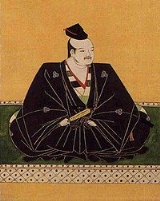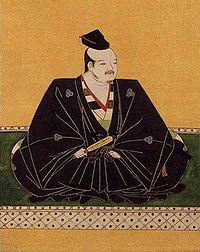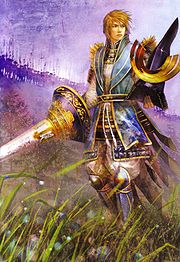
Azai Nagamasa
Encyclopedia

was a Daimyo during the Sengoku period
Sengoku period
The or Warring States period in Japanese history was a time of social upheaval, political intrigue, and nearly constant military conflict that lasted roughly from the middle of the 15th century to the beginning of the 17th century. The name "Sengoku" was adopted by Japanese historians in reference...
of Japan. His clan, the Azai, were located in northern Ōmi Province
Omi Province
is an old province of Japan, which today comprises Shiga Prefecture. It was one of the provinces that made up the Tōsandō circuit. It is nicknamed as .Lake Biwa, Japan's largest lake, is located at the center of the province...
, east of Lake Biwa. He was both the brother-in-law of Oda Nobunaga
Oda Nobunaga
was the initiator of the unification of Japan under the shogunate in the late 16th century, which ruled Japan until the Meiji Restoration in 1868. He was also a major daimyo during the Sengoku period of Japanese history. His opus was continued, completed and finalized by his successors Toyotomi...
, starting in 1564, and one of Nobunaga's enemies from 1570-1573. Nagamasa and his clan were utterly destroyed by Oda Nobunaga in August of 1573. Major battles of Azai Nagamasa include the battle of Anegawa
Battle of Anegawa
The 1570 came as a reaction to Oda Nobunaga's sieges of the castles of Odani and Yokoyama, which belonged to the Azai and Asakura clans. It was also referred to as the Battle of Nomura by the Oda and Azai clans and the Battle of Mitamura by the Asakura clan.As warriors sallied forth from the...
in 1570 and the many sieges of Odani castle between 1570 and 1573.
Azai Nagamasa was the son of Azai Hisamasa
Azai Hisamasa
was a son of Azai Sukemasa and the second head of the Azai clan.Hisamasa became the head of the clan in 1542 after his father died, but unlike his father, he was never a strong leader. Losing domains against Rokkaku clan, he instead became a Rokkaku retainer...
, from whom he inherited clan leadership in 1560. Hisamasa had been compelled to step down by many of his retainers in favor of his son, Nagamasa. Hisamasa retired, and would later commit suicide along with his son in August of 1573. Nagamasa successfully battled both Rokkaku Yoshitaka and Saitō Tatsuoki
Saito Tatsuoki
was a daimyo in Mino Province during the Sengoku period and the third generation lord of the Saitō clan. He was a son of Saitō Yoshitatsu, and a grandson of Saitō Dōsan. He was also a nephew of Oda Nobunaga's first wife, Nōhime, herself a daughter of Saitō Dōsan....
between 1560 and 1564. He is remembered as being a capable commander of troops on the battlefield.
He married Oda Nobunaga
Oda Nobunaga
was the initiator of the unification of Japan under the shogunate in the late 16th century, which ruled Japan until the Meiji Restoration in 1868. He was also a major daimyo during the Sengoku period of Japanese history. His opus was continued, completed and finalized by his successors Toyotomi...
's sister Oichi
Oichi
or a female historical figure in the late Sengoku period. She is known primarily as the mother of three daughters who married well -- Yodo-dono, Ohatsu and Oeyo....
in 1564. Nobunaga desired peaceful relations with the Azai clan because of their strategic position in between Oda clan land's and the capitol, Kyoto
Kyoto
is a city in the central part of the island of Honshū, Japan. It has a population close to 1.5 million. Formerly the imperial capital of Japan, it is now the capital of Kyoto Prefecture, as well as a major part of the Osaka-Kobe-Kyoto metropolitan area.-History:...
.
In 1570, Oda Nobunaga declared war on the Asakura family
Asakura clan
The ' are descendants of Prince Kusakabe , son of Emperor Temmu .The family was a line of daimyō which, along with the Azai clan, opposed Oda Nobunaga in the late 16th century...
of Echizen. The Asakura and Azai had been allies since the time of Nagamasa's grandfather. This sudden war between two Azai clan allies is reported to have divided the clan. Many retainers wished to honor the alliance with the Asakura, while Nagamasa himself is reported to have favored staying neutral, essentially siding with Nobunaga. In the end, the Azai clan chose to honor the generations-old alliance with the Asakura and came to their aid. Initially, this decision caused Nobunaga's army, which was marching upon the Asakura's lands to retreat back to Kyoto. However, within a few months the forces of Nobunaga were again on the march, but this time they marched on Azai lands.
In the summer of 1570, Oda Nobunaga and Tokugawa Ieyasu
Tokugawa Ieyasu
was the founder and first shogun of the Tokugawa shogunate of Japan , which ruled from the Battle of Sekigahara in 1600 until the Meiji Restoration in 1868. Ieyasu seized power in 1600, received appointment as shogun in 1603, abdicated from office in 1605, but...
brought an army estimated between 20-30,000 men into Northern Omi. The Azai called upon their allies, the Asakura, for assistance. The Asakura responded by sending troops. In either June or July, the two sides met at the battle of Anegawa
Battle of Anegawa
The 1570 came as a reaction to Oda Nobunaga's sieges of the castles of Odani and Yokoyama, which belonged to the Azai and Asakura clans. It was also referred to as the Battle of Nomura by the Oda and Azai clans and the Battle of Mitamura by the Asakura clan.As warriors sallied forth from the...
. The combined Azai and Asakura force numbered between 15-20,000 men. The outcome is recorded elsewhere, but briefly: The battle was strongly contested by both sides. Nobunaga is recorded as having decided that his force should directly confront the numerically inferior Azai clan force, while Ieyasu would engage the Asakura. While the Oda were being held at bay, and perhaps even slowly losing ground to the Azai - who had fought against numerically superior forces in the past - Ieyasu's force was apparently quickly gaining the advantage against the Asakura. Ieyasu, or perhaps one of his battle commanders, decided to send part of the Tokugawa force into the Azai flank, forcing the Azai to retreat, and guaranteeing victory. However, the battle was strategically indecisive because the Oda shortly withdrew.
Over the course of the next two years, with the exception of occasional interventions by the Shogun, Azai Nagamasa was under constant threat of Nobunaga aggression into Omi. Often these threats manifested into sieges of the Azai Capitol, Odani. During this period the Azai are seen as being loosely aligned with numerous anti-Oda forces, including the Asakura, the Miyoshi, the Rokkaku, and several religious complexes.
In 1573, Oda laid siege to Odani
Odani Castle
was a Sengoku period mountain-top castle located in the present day town of Kohoku in Higashiazai District, Shiga Prefecture, Japan. Only the ruins remain today. It was the home castle of the Azai clan and the mountain it was built upon was considered to be impregnable...
. Although the Asakura sent a relief force, Nobunaga defeated this force and chased the Asakura into their lands. Shortly thereafter, the Asakura were destroyed. Nobunaga then returned south to prosecute the siege of Odani. Nagamasa had no hope of winning, and chose to commit seppuku
Seppuku
is a form of Japanese ritual suicide by disembowelment. Seppuku was originally reserved only for samurai. Part of the samurai bushido honor code, seppuku was either used voluntarily by samurai to die with honor rather than fall into the hands of their enemies , or as a form of capital punishment...
. Before dying, he and his wife Oichi sent out their two sons to be hidden in far off place that only they knew of, while he sent out his three daughters and his wife, Nobunaga's sister, to live with Nobunaga. They were allowed to live. Later on, Oda convinced Oichi to tell him where she had sent her infant son Manpukaru saying that he wanted the boy to live with and raise him. Nagamasa's male heir, Manpukumaru, was put to the sword on Oda Nobunaga's orders by his general Hideyoshi and the head be put on a stake for all to see. Oda made sure no one told his sister, Oichi of this but soon after, since she hadn't heard word of her son yet, came to that suspicion. There are reports that Nobunaga bore a strong grudge against Nagamasa for his perceived betrayal of their alliance even though it was he who broke the agreement first. It has also been reported that Nobunaga had the skulls of Nagamasa, Hisamasa, and the Asakura leader lacquered so that they could be used as cups. Whether this report is historically accurate, or merely made up to inflate the reputation of Nobunaga is debatable at this time.
Three of Nagamasa's daughters are famous for marrying famous men. They were
- Chacha, or Yodo dono, also known as Daiko'in, concubine of Toyotomi HideyoshiToyotomi Hideyoshiwas a daimyo warrior, general and politician of the Sengoku period. He unified the political factions of Japan. He succeeded his former liege lord, Oda Nobunaga, and brought an end to the Sengoku period. The period of his rule is often called the Momoyama period, named after Hideyoshi's castle...
and mother of Hideyoshi's heir HideyoriToyotomi Hideyoriwas the son and designated successor of Toyotomi Hideyoshi, the general who first united all of Japan. His mother, Yodo-dono, was the niece of Oda Nobunaga.... - Hatsu, wife of the sengokuSengoku periodThe or Warring States period in Japanese history was a time of social upheaval, political intrigue, and nearly constant military conflict that lasted roughly from the middle of the 15th century to the beginning of the 17th century. The name "Sengoku" was adopted by Japanese historians in reference...
daimyoDaimyois a generic term referring to the powerful territorial lords in pre-modern Japan who ruled most of the country from their vast, hereditary land holdings...
Kyogoku TakatsuguKyōgoku Takatsuguwas a daimyo of Omi Province and Wakasa Province during the late-Sengoku Period of Japan's history.Takatsugu is recognized as the founder of the modern Kyōgoku clan. His forebears had been powerful since the 13th century, but their fortunes had waned after the Ōnin War... - OeyoOeyo, , or : 1573 – September 15, 1626) was a prominently-placed female figure in late-Sengoku period. She married three times, first to Saji Kazunari, then to Toyotomi Hideyoshi's nephew Toyotomi Hidekatsu. Her third and last husband Tokugawa Hidetada became the second Tokugawa shogun...
, or Sūgen'in, wife of the second Tokugawa shogun HidetadaTokugawa Hidetadawas the second shogun of the Tokugawa dynasty, who ruled from 1605 until his abdication in 1623. He was the third son of Tokugawa Ieyasu, the first shogun of the Tokugawa shogunate.-Early life :...
and mother of his successor and elder son IemitsuTokugawa IemitsuTokugawa Iemitsu was the third shogun of the Tokugawa dynasty. He was the eldest son of Tokugawa Hidetada, and the grandson of Tokugawa Ieyasu. Iemitsu ruled from 1623 to 1651.-Early life :...
.
Modern References

- Nagamasa makes appearances as a general in the Main Campaign and in various Historical Battles and Historical Campaigns in the PC game Shogun Total War. Additionally, Nagamasa returns as an Heir to the Azai Clan in the fan created Samurai Warlords Mod (aka the Shogun Mod) for the PC game Medieval Total WarMedieval: Total WarMedieval: Total War is a turn-based strategy and real-time tactics computer game developed by The Creative Assembly and published by Activision. Set in the Middle Ages, it is the second game in the Total War series, following on from the 2000 title Shogun: Total War...
. - Nagamasa is a featured playable character within the video game series Samurai WarriorsSamurai Warriorsis the first title in the series of video games created by Koei's Omega Force team based loosely around the Sengoku period of Japanese history and it is a spinoff of the Dynasty Warriors series...
, in which he is depicted as an extremely honorable man who will stop at nothing to ensure that his notions of justice are enforced. As like in history, Nagamasa decides to collaborate with his erstwhile allies, the Asakura, and fight against Nobunaga at Anegawa; he also expresses a more dramatized showing of love towards his respective wife, Oichi, and cares deeply for her welfare. In appearance, Nagamasa is depicted with his traditional kabuto helmet and carries a lance as his weapon of choosing. This version of the character also appears in the spin-off series Warriors OrochiWarriors Orochi, is a PlayStation 2 and Xbox 360 hack and slash video game developed by Koei and Omega Force. It is a crossover of two of Koei's popular video game series, Dynasty Warriors and Samurai Warriors...
as an unlockable character for the Cao WeiCao WeiCao Wei was one of the states that competed for control of China during the Three Kingdoms period. With the capital at Luoyang, the state was established by Cao Pi in 220, based upon the foundations that his father Cao Cao laid...
storyline. Cao PiCao PiCao Pi , formally known as Emperor Wen of Wei, was the first emperor of the state of Cao Wei during the Three Kingdoms period of Chinese history. Born in Qiao County, Pei Commandery , he was the second son of the late Han Dynasty warlord Cao Cao.Cao Pi, like his father, was a poet...
and Mitsunari Ishida attack Nagamasa's forces, including his wife OichiOichior a female historical figure in the late Sengoku period. She is known primarily as the mother of three daughters who married well -- Yodo-dono, Ohatsu and Oeyo....
and Gan NingGan NingGan Ning was a military general serving under the warlord Sun Quan during the late Han Dynasty period of Chinese history. He was born in Linjiang, Ba Commandery .-Early life as a pirate:...
of Wu. Instead of death, as they wanted, Cao Pi enlists the three of them into his army against Orochi. - Nagamasa is an NPC in Sengoku Basara 2Sengoku Basara 2Sengoku Basara 2 is a sequel to the video game Sengoku Basara , released in Japan on July 27, 2006 for the PlayStation 2. A revision with additional features named Sengoku Basara 2 Heroes was released on November 29, 2007...
, along with Oichi, but becomes playable in the expansion Sengoku Basara 2: Heroes. He wields a long sword and carries a shield with him and is portrayed as a justice loving man.

